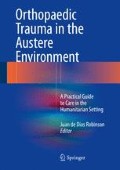Abstract
Compartment syndrome and crush syndrome are two closely related clinical entities. Both arise as a consequence of trauma to muscle, which results in swelling and a compromised circulation to muscles and nerves at the microvascular level. If reperfusion of the tissue isn’t restored as quickly as possible, then tissue ischaemia may culminate in cell death and the crippling wholesale loss of muscle compartments. It may be useful to think of compartment syndrome in terms of a localised problem within an osteo-fascial muscle compartment. This is characterised by relentlessly worsening pain in the injured limb. The only effective treatment is fasciotomy which decompresses the ischaemic muscle, allowing it to be reperfused and so rescuing it from death. Fasciotomy is an emergency procedure!
Crush syndrome may arise as a result of a neglected compartment syndrome or directly from severe injury. In crush syndrome the products of muscle cell damage lead to systemic problems which manifest as hyperkalaemia, acidosis, myoglobinuria, and renal failure. When a patient is freed from limb entrapment, reperfusion initiates this process; the most urgent danger is from hyperkalaemia leading to cardiac dysrhythmias and sudden death. Amputation can be life-saving if there are no means or resources to medically manage the hyperkalaemia and later renal failure. The decision whether to perform fasciotomies in crush syndrome is determined by the duration of ischaemia. If this is greater than 6–8 h, the muscle will not be rescued. The patients’ compartments should be left closed, provided the life-threatening metabolic consequences of hyperkalaemia and myoglobinuria can be managed medically. If not, amputation should be performed swiftly.
Access this chapter
Tax calculation will be finalised at checkout
Purchases are for personal use only
References
Porter K, Greaves I. Crush injury and crush syndrome: a consensus statement. Emerg Nurs J RCN Accid Emerg Nurs Assoc. 2003;11(6):26.
Ritenour AE, Dorlac WC, Fang R, Woods T, Jenkins DH, Flaherty SF, et al. Complications after fasciotomy revision and delayed compartment release in combat patients. J Trauma. 2008;64(2):S153–62.
Tornetta Iii P, Templeman D. Instructional course lectures, the American academy of orthopaedic surgeons – compartment syndrome associated with tibial fracture*†. J Bone Joint Surg. 1996;78(9):1438–44.
Clasper JC, Standley D, Heppel S, Jeffrey S, Parker PJ. Limb compartment syndrome and fasciotomy. J R Army Med Corps. 2009;155(4):298–301.
Mars M, Hadley G. Raised intracompartmental pressure and compartment syndromes. Injury. 1998;29(6):403–11.
Mars M, Hadley G. Raised compartmental pressure in children: a basis for management. Injury. 1998;29(3):183–5.
McQueen M. Compartment monitoring in tibial fractures. The pressure threshold for decompression. J Bone Joint Surg Br. 1996;78(1):99–104.
Kuwagata Y, Oda J, Tanaka H, Iwai A, Matsuoka T, Takaoka M, et al. Analysis of 2,702 traumatized patients in the 1995 Hanshin-Awaji earthquake. J Trauma Acute Care Surg. 1997;43(3):427–32.
Oda J, Tanaka H, Yoshida T. Analysis of 3732 patients with crush syndrome caused by the Hanshin-Awaji earthquake. J Trauma. 1997;42:470–6.
Pallister I, Rahman S, Atherton S. The poke test in lower limb fasciotomy: a potentially limb saving technical note. Ann R Coll Surg Engl. 2012;94:532.
Taylor G, Pan W. Angiosomes of the leg: anatomic study and clinical implications. Plast Reconstr Surg. 1998;102(3):599–616.
Nanchahal J, Nayagam S, Khan U, Moran C, Barrett S, Sanderson F, et al. Standards for the management of open fractures of the lower limb. UK: The Royal Society of Medicine Press Ltd; 2009.
Author information
Authors and Affiliations
Corresponding author
Editor information
Editors and Affiliations
Rights and permissions
Copyright information
© 2016 Springer International Publishing Switzerland
About this chapter
Cite this chapter
Pallister, I. (2016). Management of Compartment Syndrome and Crush Syndrome. In: Robinson, J. (eds) Orthopaedic Trauma in the Austere Environment. Springer, Cham. https://doi.org/10.1007/978-3-319-29122-2_28
Download citation
DOI: https://doi.org/10.1007/978-3-319-29122-2_28
Published:
Publisher Name: Springer, Cham
Print ISBN: 978-3-319-29120-8
Online ISBN: 978-3-319-29122-2
eBook Packages: MedicineMedicine (R0)

